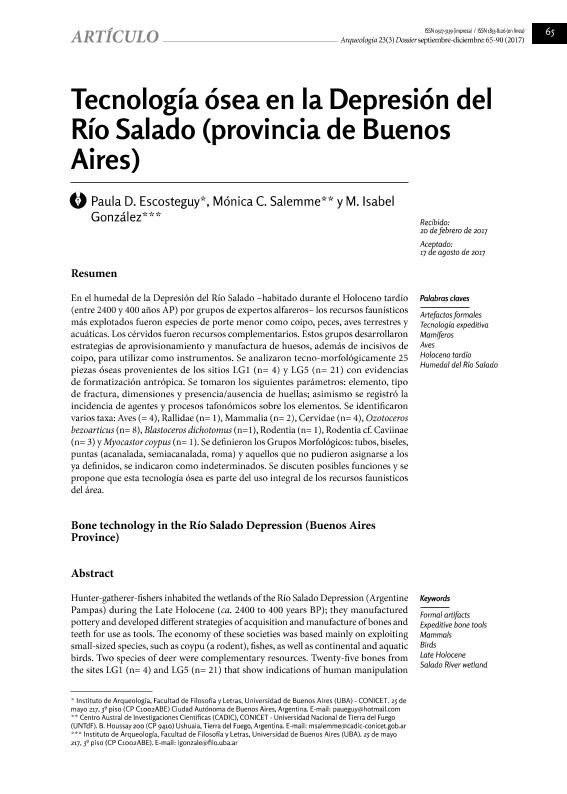Artículo
En el humedal de la Depresión del río Salado -habitado durante el Holoceno tardío (entre 2400 y 400 años AP) por grupos de expertos alfareros- los recursos faunísticos más explotados fueron especies de porte menor como coipo, peces, aves terrestres y acuáticas. Los cérvidos fueron recursos complementarios. Estos grupos desarrollaron estrategias de aprovisionamiento y manufactura de huesos, además de incisivos de coipo, para utilizar como instrumentos. Se analizaron tecno-morfológicamente 25 piezas óseas provenientes de los sitios LG1 (n=4) y LG5(n=21) con evidencias de formatización antrópica. Se tomaron los siguientes parámetros:elemento, tipo de fractura, dimensiones y presencia/ausencia de huellas; asimismo se registró la incidencia de agentes y procesos tafonómicos sobre los elementos. Se identificaron varios taxa: Aves (=4), Rallidae (n=1), Mammalia (n=2), Cervidae (n=4), Ozotoceros bezoarticus (n=8), Blastoceros dichotomus (n=1), Rodentia (n=1), Rodentia cf. Caviinae (n=3) y Myocastor coypus (n=1). Se definieron los Grupos Morfológicos: tubos, biseles, puntas (ahuecada, acanalada,semiacanalada, roma) y aquellos que no pudieron asignarse a los ya definidos, se indicaron como indeterminados. Se discuten posibles funciones y se propone que esta tecnología ósea es parte del uso integral de los recursos faunísticos del área. Hunter-gatherer-fishers inhabited the wetlands of the Río Salado Depression (Argentine Pampas) during the Late Holocene (ca. 2400 to 400 years BP); they manufactured pottery and developed different strategies of acquisition and manufacture of bones and teeth for use as tools. The economy of these societies was based mainly on exploiting small-sized species, such as coypu (a rodent), fishes, as well as continental and aquatic birds. Two species of deer were complementary resources. Twenty-five bones from the sites LG1 (n= 4) and LG5 (n= 21) that show indications of human manipulation were subjected to a techno-morphological analysis. The following parameters were considered: material, type of fracture, dimensions and presence/absence of marks; the effects of taphonomic agents and processes on bone surfaces are evaluated as well. Human modification on the bones of several taxa were identified: Aves (n= 4), Rallidae (n= 1), Mammalia (n= 2), Cervidae (n=4), Ozotoceros bezoarticus (n=8), Blastoceros dichotomus (n= 1), Rodentia (n= 1), Rodentia cf. Caviinae (n= 3) and Myocastor coypus (n= 1). On this basis, we characterized the Morphological Groups as, tubes, bevelled tools, points (channelled, semi-channeled, blunt-ended), and those tools not allocated to these groups, were designated as Undetermined. The potential function of these tools is discussed, we propose that bone technology was part of the integral use of faunal resources in the area.
Tecnología ósea en la Depresión del Río Salado (provincia de Buenos Aires)
Título:
Bone technology in the Río Salado Depression (Buenos Aires Province)
Fecha de publicación:
12/2017
Editorial:
Universidad de Buenos Aires. Facultad de Filosofía y Letras. Instituto de Arqueología
Revista:
Arqueología (Buenos Aires)
ISSN:
0327-5159
e-ISSN:
1853-8126
Idioma:
Español
Tipo de recurso:
Artículo publicado
Clasificación temática:
Resumen
Archivos asociados
Licencia
Identificadores
Colecciones
Articulos(CADIC)
Articulos de CENTRO AUSTRAL DE INVESTIGACIONES CIENTIFICAS
Articulos de CENTRO AUSTRAL DE INVESTIGACIONES CIENTIFICAS
Articulos(SEDE CENTRAL)
Articulos de SEDE CENTRAL
Articulos de SEDE CENTRAL
Citación
Escosteguy, Paula Daniela; Salemme, Monica Cira; Gonzalez de Bonaveri, Maria Isabel; Tecnología ósea en la Depresión del Río Salado (provincia de Buenos Aires); Universidad de Buenos Aires. Facultad de Filosofía y Letras. Instituto de Arqueología; Arqueología (Buenos Aires); 23; 3; 12-2017; 65-90
Compartir




